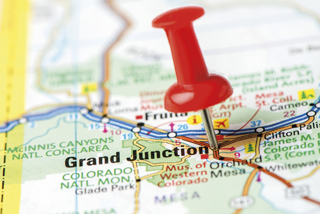West Slope city on the rebound
Stung by the oil shale crash, Grand Junction leans on outdoor appeal, Western feel
Margaret Jackson //December 5, 2014//


West Slope city on the rebound
Stung by the oil shale crash, Grand Junction leans on outdoor appeal, Western feel
Margaret Jackson //December 5, 2014//

The boom and bust in the energy industry on Colorado’s Western Slope has taken its toll on Grand Junction, which stands in stark contrast to other parts of the state that have come back from the Great Recession.
The area is still 3,000 jobs short of its pre-recession level, so now it’s focused on bringing new industries to the region to combat the erosion of jobs, specifically in the oil and gas industry.
“For a long time, the economy over here was really humming along,” said Sam Suplizio, a broker with Bray & Co. Commercial in Grand Junction. “We recovered nicely from some of the things in the ‘80s that were so devastating – there was the oil shale crash. Now, we’d like to diversify. The whole energy extraction thing is great, but when it goes away, we really feel the effect.”
The loss of energy companies has had a noticeably negative impact on the community’s real estate market, particularly industrial properties. While office and retail appear to have bounced back, industrial properties are selling at a fraction of what they were commanding six years ago. The apartment market also has remained strong, though the lack of jobs and the city’s overarching economic sluggishness make it difficult to break ground on new multifamily projects.
According to Bray’s 2nd quarter commercial real estate report:
• A national retailer is planning a new location
• FedEx Ground is building a 48,000-square-foot facility
• City Market is looking at building a new store on property it owns at North 12th Street and Patterson Road
• The Pilot and Loves truck stops have been completed
“Jobs on the retail level are coming in, but that doesn’t lend itself to a vibrant, stable economy,” Suplizio said. “It’s still precarious and fragile. If a new restaurant comes in, that’s super. But somebody else is going out of business. The town is not vibrant enough to support that.”
Though the unemployment rate is relatively low at 6.3 percent, the number of jobs that left the region sucked the money those workers spend with it.
There are, however, opportunities for investors – particularly in industrial properties that were abandoned when the oil and gas industry relocated employees to Texas, Oklahoma and North Dakota.
“Industrial land prices dropped about 50 percent when oil and gas pulled out, and they’re still there,” said Dale Beede, a broker with Coldwell Banker Commercial Prime Properties in Grand Junction, who estimates the region has lost about 20,000 jobs since 2008. “We just haven’t had a need for new industrial buildings.”
If the Grand Junction Economic Partnership is successful in its mission to broaden the city’s employment base, industrial real estate could recover as well. The economic development organization is focused on attracting businesses from five target industries:
Aviation and aerospace
Energy
Manufacturers of outdoor recreational products
Medical and health care
IT and professional services
OUTDOOR OPERATIONS
“Recently, we’ve really focused our marketing efforts on the outdoor recreational industry,” said Laura Peters, communications director for the Grand Junction Economic Partnership. “We attend Outdoor Retailer twice a year to get prospects.”
The partnership wants to build on its reputation as an outdoor mecca, known for world-class trails, rafting, cycling, fishing and skiing. It’s prospecting for businesses that will complement companies that already have a presence in town, including DT Swiss USA, Mountain Racing Products, Loki Outerwear, Honey Skateboards and Leitner-Poma of America.
Among the selling points the partnership touts is the opportunity to test outdoor equipment in the terrain where it will be used; the quality of life that appeals to a qualified work force; its No. 6 ranking on America’s Top Towns for Sportsmen; and a variety of tax incentives, including the locally administered Enterprise Zone program. It also claims having a “Made in Colorado” tag will provide instant credibility to outdoor enthusiasts.
“We’ve seen an increase in the number of prospects and leads we’ve had over the last year,” Peters said. “We have at least one new one every month. We’re seeing the economy turn around and more local businesses expand and gain employees.”
With its gigantic red rocks, deep canyons and large boulders, the Grand Junction area is a hub for rock climbers. Perhaps that’s why Dave Cummings recently opened Grand Valley Climbing, a 12,316-square-foot climbing facility that also offers yoga, fitness and strength training. Cummings has boasted that the facility has the tallest indoor climbing gym in Colorado with 14,000 square feet of climbable surface.
MEDICAL MOTIVATION
Another bright spot on the Grand Junction commercial real estate scene is the medical industry. Community Hospital is expanding; St. Mary’s Hospital completed an expansion before the economy crashed; and the Redlands Mesa Surgery Center recently opened a 27,000-square-foot facility.
“The medical community is quite strong and is still growing,” Beede said. “Every specialty now is represented.”
Located in the high desert, Grand Junction’s stunning views of the canyons and monoliths of the Colorado National Monument to the west, Grand Mesa, the world’s largest flat-topped mountain to the southeast, and Little Bookcliffs to the northeast are assets to the expanding community. The city is expected to grow at a stronger rate than the Denver metro area over the next 25 years, according to the Grand Junction Economic Partnership. In-migration accounts for more than 80 percent of the gain in any given year, and the trend is expected to continue, as people are attracted to the area’s Western wildness.
That’s been positive for the residential real estate market, where the median price for a home is $184,900 – a $15,000 increase from a year ago.






















